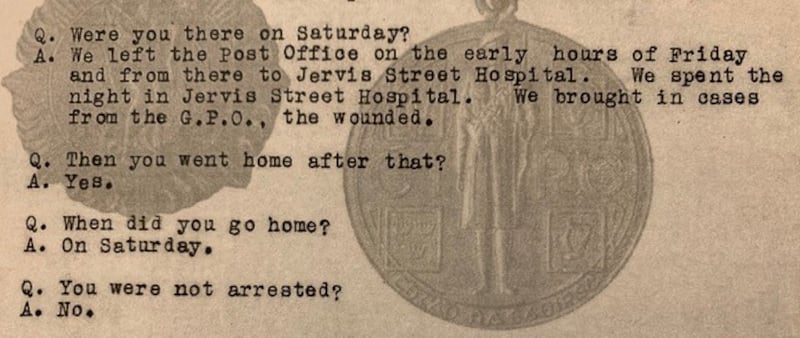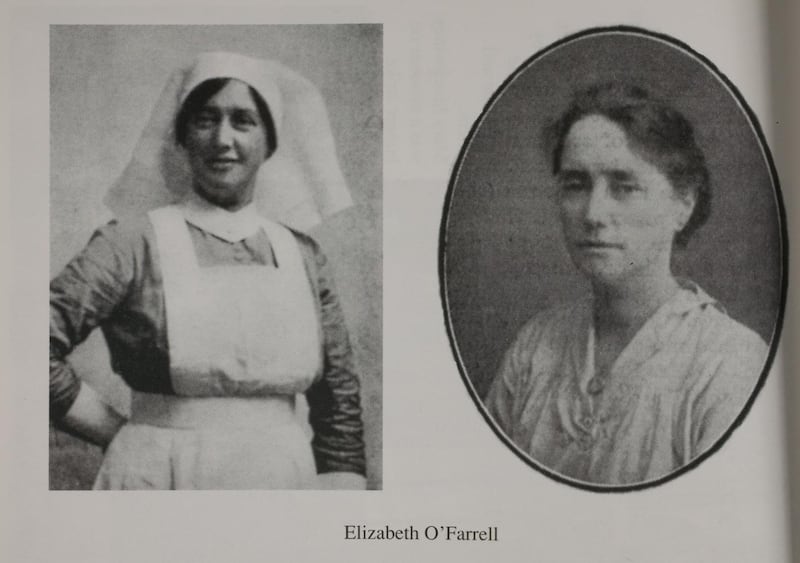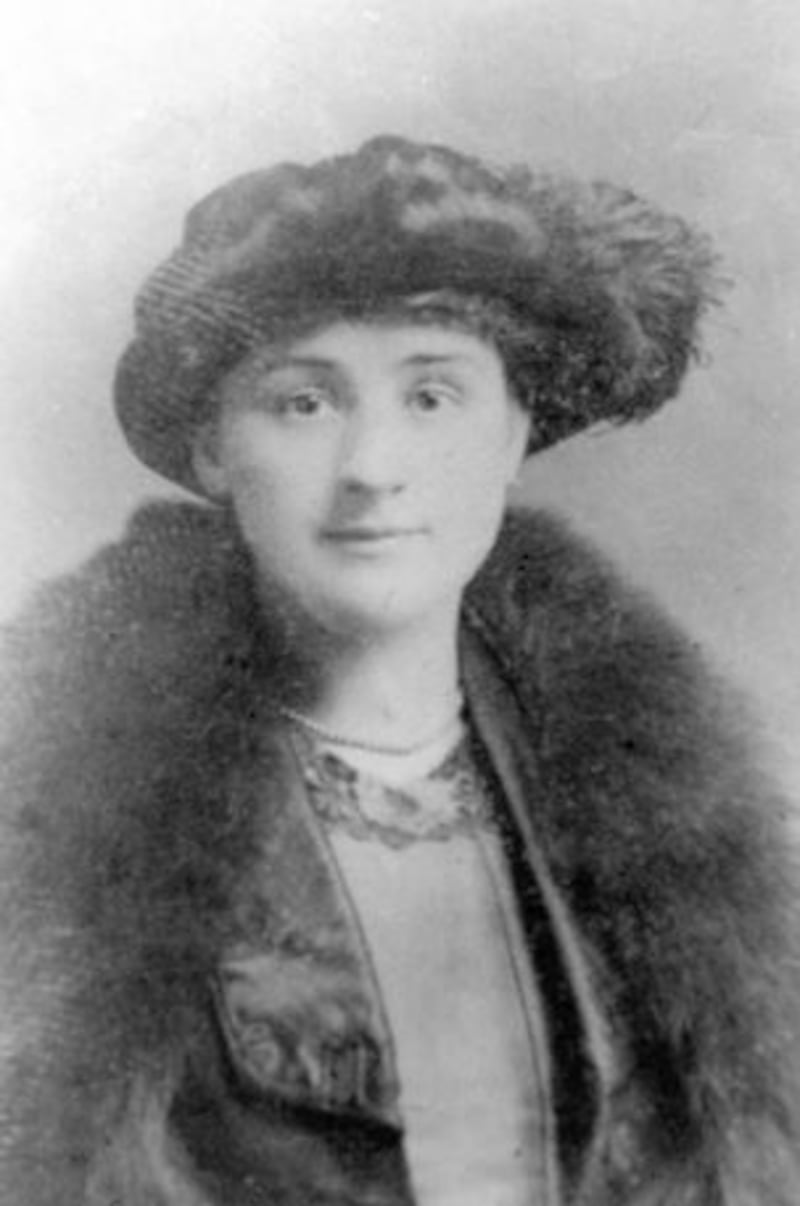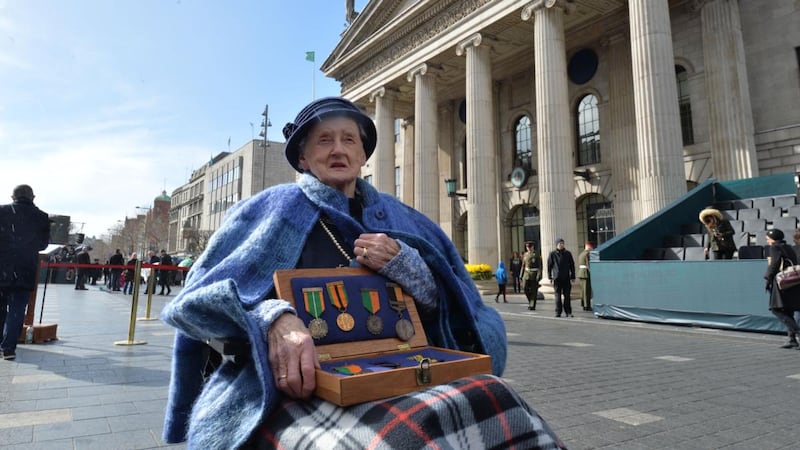When the worldwide call from the Irish health services came to Irish citizens, for frontline assistance with the emerging Covid-19 crisis in Ireland, my thoughts turned to how to serve my country of birth from my adopted home in Melbourne. In the following days, as isolation, physical distancing and nationwide travel restrictions became a new reality in Australia, I thought about the resilience and resourcefulness of Irish women before me, who had survived tough times and made a significant contribution to their country.
One previously unnamed and forgotten group of 12 Irishwomen came immediately to mind, and the story of their harrowing journey through the 1916 battlefield. One of the women in this group was my maternal grandmother Lucy Agnes Smyth.
These inspirational women from the General Post Office (GPO) Cumann na mBan nursing contingent ferried the wounded under grave danger to Jervis Street Hospital on the eve of the surrender Friday, April 28th in 1916.
I have only one memory of my grandmother. The image is of an elderly woman, slight in stature dressed in black and wearing a hat, making her way tentatively down the tarmacadam front driveway of my childhood home on the Howth Road in Clontarf, Dublin almost a half a century ago. My mother, Sheila O'Leary, remembered her mother as loving, competent, dignified and reserved.
My grandmother Lucy Smyth was a member of Cumann na mBan’s central branch since its inception in 1914. She arrived at the GPO on Easter Monday and was assigned duties as part of the nursing contingent.
I read through Lucy's recently released, substantial military history pension files. On her whereabouts during Easter Week, she wrote that on the Friday evening before the surrender that she was "accompanying the wounded to Jervis Street". I've used these pension files, statements given from the group to Bureau of Military History and researched files from primary and secondary sources to document what happened the group that week.

On the eve of the surrender the number of women remaining in the GPO were about 35, though there were close to 70 women who had showed up for duty earlier in the week. At noon on Friday as the fires encroached the GPO general headquarters Pádraig Pearse said he wished “that everyone who was not qualified in first aid should leave, as the fighting would get very severe”.
About 20 women left reluctantly under orders, carrying messages from the other volunteers to bring to their loved ones. After this group left, Tom Clarke, Seán MacDiarmada, Joseph Plunkett, Pádraig Pearse and The O'Rahilly gathered around the bed of the wounded James Connolly to prepare a plan of evacuation from the burning building for the now 400 plus garrison.
At 6.30pm Joseph Plunkett gave the firm order to get all the wounded men ready. The injured James Connolly, although in agonising pain refused to go to Jervis Street Infirmary. He said he would "remain with his men to the last". Three women, Elizabeth O' Farrell and her lifelong friend Julia Grenan who both had nursing training, and Winifred Carney, a gifted markswoman and James Connolly's trusted confidante, remained with the leaders. Plans for the GPO garrison to join up with the Four Courts garrison were abandoned in favour of going to nearby Moore Street to set up the new general headquarters of the provisional government of the Irish republic.

Five of the signatories to the Proclamation and hundreds of volunteers occupied the surrounding laneways, courtyards, cellars and out buildings, tunnelling and mouse-holing through the terrace of 16 houses on Moore Street. Many civilians were caught up in the mayhem including children and elderly people. To avoid further civilian casualties, it was from No 16 Moore Street that Elizabeth O'Farrell was sent by Pearse under the protection of a white flag to meet with Brigadier General William Lowe with a request to enter into negotiations, the next day, Saturday.
The plan to evacuate the wounded was enacted swiftly at dusk. James Connolly had earlier dictated instructions to begin to tunnel through the houses on the Henry Street side of the GPO, to prepare a strategic vantage point and a escape route out of the line of fire. This was not tenable now with the wounded on stretchers. Neither the cellars nor the filthy sewers were deemed a suitable place of safety.
Accompanying the 12 women and the wounded, were a priest Fr John Flanagan, chief medical officer John Doyle, and two medical students. A prisoner who was also a medical doctor George Mahony accompanied the group. My research found that eight volunteers disguised as Red Cross men were appointed as escorts with Desmond Fitzgerald at the helm.
As they set off the women were weary as they had not slept properly all week and were now heavily burdened. The wounded were wrapped in blankets and carried on stretchers. They never complained.
"The group reached a building facing Moore Street and one of the girls, momentarily forgetting precautions, crossed the room in front of a window. Immediately there was a shower of bullets, fired by the British at the Parnell Street end of Moore Street where there was a barricade, and they nearly added another casualty to their list," Molly Reynolds from Cumann na mBan said in An t-Óglach magazine in March 1926.
The women prepared to die by saying acts of contrition. Statements given revealed Fr Flanagan comforted them, and they in turn comforted the wounded with prayers and the rosary. They prayed to be spared or to have a good death. They waited at the nearby Coliseum Theatre for what seemed like an eternity. When there was a lull in gunfire they gathered up their belongings, food and medical supplies and tentatively passed along the upper balcony in the Coliseum Bar in darkness and in silence, thought the noise outside was deafening. They hesitantly made their way back through the GPO courtyard and with the help of two volunteers who had been sent back to the GPO to check everyone had left, proceeded to Jervis Street via Princes Street and Abbey Street.

When the embattled group got to Princes Street and to Williams Lane, to their horror the entrance to the laneway was heavily barricaded and on fire.They were trapped. They could hear the sounds of heavy artillery. The the air was dense with smoke making it difficult to breathe. The women knelt and Fr Flanagan gravely began administering conditional absolution to prepare them for imminent death. The barricade was roughly four feet high and a quick-witted volunteer began climbing it and trampled it down to a lower level. Every second counted. Fr Flanagan's shrill voice rang out, "We'll rush the flames, it's our only chance, let's all follow me".

The women hoisted their skirts and fled through with no further casualties in spite of having to negotiate another barricade of petrol tins at the other end of the laneway. Their appearance on Abbey Street was greeted with a fusillade of bullets by the British military. They crossed fleetingly to the other side of the street where they rested, exhausted. Taking matters into their own hands Fr Flanagan and prisoner Dr George Mahony, still in his khaki uniform, proceeded towards Jervis Street Hospital to seek admission for them.
It was about 11.30pm at night when the group was escorted to the hospital, records from my research showed. The badly wounded were admitted only. After much negotiation and pleading, the women were allowed to spend the night in the waiting room of the dispensary, on the cold floor and with no covers. They were mistakenly thought to be dead bodies by a nurse who stumbled upon them. Early on the Saturday morning the military officer told them they could go home, and if they were held up, to refer to him. They met with no opposition until they reached the Parnell Monument. On being asked who they were, and what their business was they replied "Red Cross Nurses from Jervis Street Hospital". After some debate as to where Jervis Street was and whether they were really Red Cross Nurses, the weary group were finally allowed to pass.

On the opposite side of the road to them in the yard at the Rotunda Maternity Hospital were lined up many of the volunteers and leaders of the Rising. The women passed without acknowledging them for fear of capture. They reached Portland Row were some were recognised as members of Cumann na mBan by detectives. They were halted and threatened to be searched. One of the women carried a copy of the Proclamation in a bag. They stood steadfastly by their story and eventually all repaired safely to the house of one of the women to spend an anxious night. My grandfather Captain Thomas Byrne (Boer Tom), who had mobilised the troops from Kildare, and led them into to the GPO on Tuesday morning, also escaped detection and went on the run in disguise with Lucy's assistance that Saturday evening. Had he been captured he would have been executed given his involvement in the earlier Anglo Boer War. In the following years, Lieutenant Lucy Smyth was an active member of the Irish National Aid Association and Volunteer Dependents Fund. Many of the other combatant women took up prominent roles in the War of Independence and Civil War and later in public, civic and domestic life.
These 12 women pledged their lives for an independent and equal Ireland, and by their deeds put the welfare of each other and their charges to the fore in the line of duty. Their names to remember are:
1. Aoife de Burca
2. Elizabeth "Lillie" Burke (McGinty)
3. Louise Gavan Duffy
4. Lucy Smyth (Byrne)
5. Martha "Birdie" Walsh (Slater)
6. Molly Reynolds
7. Margaret McElroy
8. Mary Josephine "Mary Jo" Walsh (Rafferty)
9. Margaret Walsh (Jenkins)
10. Matilda "Tilly" Simpson
11. Peggy Downey
12. Stasia Byrne (Toomey)










